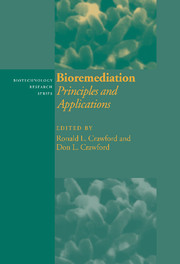Book contents
- Frontmatter
- Contents
- List of contributors
- Preface
- Introduction
- 1 Engineering of bioremediation processes: needs and limitations
- 2 Bioremediation in soil: influence of soil properties on organic contaminants and bacteria
- 3 Biodegradation of ‘BTEX’ hydrocarbons under anaerobic conditions
- 4 Bioremediation of petroleum contamination
- 5 Bioremediation of environments contaminated by polycyclic aromatic hydrocarbons
- 6 Bioremediation of nitroaromatic compounds
- 7 A history of PCB biodegradation
- 8 Bioremediation of chlorinated phenols
- 9 Biodegradation of chlorinated aliphatic compounds
- 10 Microbial remediation of metals
- 11 Molecular techniques in bioremediation
- Index
2 - Bioremediation in soil: influence of soil properties on organic contaminants and bacteria
Published online by Cambridge University Press: 28 October 2009
- Frontmatter
- Contents
- List of contributors
- Preface
- Introduction
- 1 Engineering of bioremediation processes: needs and limitations
- 2 Bioremediation in soil: influence of soil properties on organic contaminants and bacteria
- 3 Biodegradation of ‘BTEX’ hydrocarbons under anaerobic conditions
- 4 Bioremediation of petroleum contamination
- 5 Bioremediation of environments contaminated by polycyclic aromatic hydrocarbons
- 6 Bioremediation of nitroaromatic compounds
- 7 A history of PCB biodegradation
- 8 Bioremediation of chlorinated phenols
- 9 Biodegradation of chlorinated aliphatic compounds
- 10 Microbial remediation of metals
- 11 Molecular techniques in bioremediation
- Index
Summary
Introduction to the soil system
One of the major obstacles in bioremediation of soils contaminated with synthetic organic compounds is the failure of laboratory remediation schemes to simulate the impact of field soil conditions on both the contaminant and the microorganism (Rao et al., 1993). The purpose of this chapter is to introduce those topics which must be considered in order to develop an effective bioremediation strategy for soils contaminated with organic pollutants. My emphasis is on providing a comprehensive overview of the complexity of the soil system as it relates to bioremediation.
The soil environment is a dynamic one which includes gas, liquid, and solid phases. It is imperative in any soil bioremediation process to have a clear understanding of these phases and how they interact. This includes not only the chemical characteristics of soil colloids, but the physical arrangement of components. The first section is meant as a brief introduction to soil chemical and physical properties and is intended primarily for those unfamiliar with the area.
The inorganic solid phase in soil
The solid phase consists of both inorganic and organic components, which in many cases form a heterogeneous mixture defined as organo-mineral complexes. In-depth treatments of soil chemistry, humus chemistry, and mineralogy are available (Aiken et al., 1982; Bohn et al., 1985; Dixon and Weed, 1989; Sposito, 1989; McBride, 1994; Stevenson, 1994). Soil inorganic components include both crystalline materials in the form of layer silicates as well as more poorly crystalline oxides, hydroxides, and oxyhydroxides (collectively termed hydrous oxides).
- Type
- Chapter
- Information
- BioremediationPrinciples and Applications, pp. 35 - 60Publisher: Cambridge University PressPrint publication year: 1996
- 6
- Cited by



